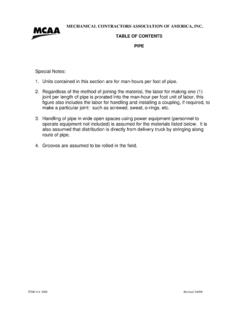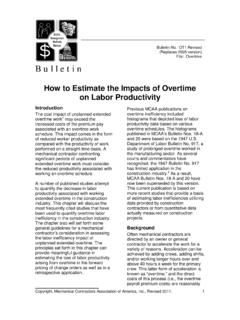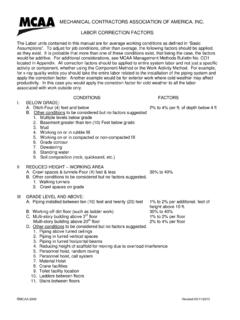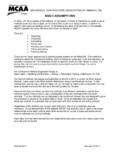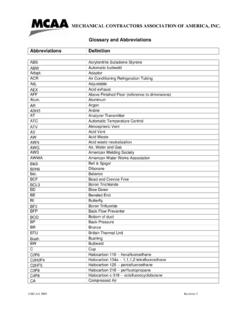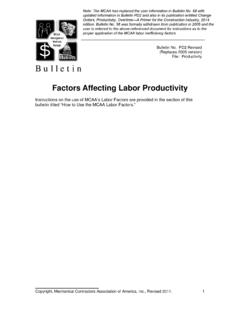Transcription of MCAA Management Methods Manual - How Much …
1 B u l l e t i n Bulletin No. OT 1 RevisedFile: Overtime How much Does Overtime Really Cost? INTRODUCTION It has become well-recognized that the costs of overtime are far higher than the extra wage rates, calculated on a one and one-half or double time basis. In instances where a schedule of 60 hours a week continues for more than about two months, productivity plunges so dramatically that the project completion date stretches beyond what it would have been with the same crew working a 40-hour week. Absenteeism increases, injuries rise, and as much as twice the time may be taken to do a normal hour of work. (See Guideline on Overtime, Con-struction Costs and Productivity at ). The guideline cited above noted that studies on productivity losses due to prolonged overtime conducted by the Bureau of Labor Statistics of the Department of Labor, the Procter and Gamble Company, the Business Roundtable, the National Electrical Contractors Association, and the Mechanical Contractors Association of America produced similar results.
2 All showed that continuing scheduled overtime has a strong negative effect on productivity which increases in magnitude proportionate to the amount and duration of overtime. Abandonment of the overtime schedule appears to be the only effective remedy. Construction projects in which prolonged overtime occurs also disrupt the economy of an area by creating a bidding atmos-phere, whereby other projects are forced to go on overtime to retain their labor (See Figure 1). EFFECT ON WORKERS AND PROJECTS Overtime has been shown to lower both work output and efficiency through physical fatigue and poor mental attitude. Proving that overtime has caused a decrease in productivity could help contractors recoup losses incurred in running a job at less than normal standards of work output. Studies made in this country and abroad on physical and psychological slowdown due to overwork reveal that each individual has a fixed number of energy units, which he or she is able and willing to devote to a job each day.
3 Workers automatically, and quite unconsciously, adjust their pace to expend that full quota of energy units over the total number of hours worked. For example, assume a worker is capable of expending 12 units in the course of a day. Some energy is devoted to output producing activities. Other energy is consumed by merely being present on the job, walking, standing, sitting, etc., regardless of Copyright, Mechanical Contractors Association of America, Inc., Revised 2003. 1 whether productivity is being achieved or not. A PERIOD OF READJUSTMENT To illustrate, if a worker is on the job for 8 hours assuming 12 energy units 8 are consumed productively and 4 are dissipated in nonproductive activity. When the same worker is on the job 10 hours, 5 units will be consumed unproductively. This leaves only 7 units of productive activity.
4 Thus, according to the studies, less productivity will be incurred in 10 hours than in 8. Studies also point out that upon return to shorter hours, several days will be needed for workers to readjust their pace and output rate. In other words, they will continue productive output at the slower 10-hour rate, even though they have returned to an 8-hour sche-dule. Furthermore, a worker called upon to work on a 10-hour, instead of an 8-hour, shift is likely to work at a rate adapted to the 10-hour period. This would happen not only on longer work days, but all the time. For this reason, when overtime is anticipated, it is advis-able to spread it out evenly throughout the week rather than concentrating it all in one- or two-day periods. ECONOMIC FACTORS Whatever the number of hours normally worked even if they are reduced to 36 a week overtime has one dangerous effect: the balance between output and hours of work is upset.
5 Overtime has a gradually increasing effect on such efficiency killers as fatigue and attitude. It may take a worker a long time to regain equilibrium. How does this phenomenon affect mechanical contractors? Where does it hurt them the most? The obvious answer is that the real cost of overtime is far more considerable than the immediate hours worked. Therefore, when mechanical contractors enter into contracts that provide reimbursement for only a net dollar cost of any overtime required, they are losing money. The loss occurs through reduction of labor productivity, both on the overtime period itself and on the normal hours or days immediately following such overtime. A CASE IN POINT To strengthen his position in justifying a request for additional compensation on future contracts, a Midwestern mechanical contractor used a graphic composite analysis, which dramatically illustrates the full impact of the efficiency loss under various conditions (see Figure 2).
6 According to a Bureau of Labor Statis-tics official, the study was conducted during and immediately after World War II, but the findings on the relation be-tween various types of daily and weekly schedules of hours and output and absenteeism are probably still valid. Using the chart, the contractor was able to file a claim, justifying his demand for $140,000 additional com-pensation on one single project. LOSS OF EFFICIENCY CLAUSE Since then, the contractor in-cludes a loss of efficiency clause in his contracts. This clause reads: The noted price (labor cost) is based on all work being per-formed on a straight time basis. Should overtime be required to compete with other local projects in order to attract sufficient man-power, these overtime hours, interpreted as all hours worked, shall be invoiced at cost, plus a loss of efficiency factor of 17 percent, based on a schedule of Copyright, Mechanical Contractors Association of America, Inc.
7 , Revised 2003. 2 six 10-hour days; and 28 per-cent, based on seven 12-hour days. This clause was used only for scheduled overtime, not spot overtime. The efficiency factor varies, depending upon the predetermined amount of over-time work to be performed, the number of men required, and the deadline set for completion of a given project. How-ever, the basis for that factor remains constant, as shown by the curves on the chart. PRACTICAL CONSIDERATIONS Overtime cannot be eliminated. However, the cost of operating beyond scheduled overtime periods can be compensated. This can be achieved by: Understanding the relationship be-tween overtime and inefficiency Insisting that contracts include a clause providing for compensation based on an inefficiency factor Applying the inefficiency factor to bare labor costs only and appro-priate factors for payroll taxes and insurance Adding overhead and profit Inclusion of a standardized clause, similar to the one mentioned above, should offer some relief to con-tractors who either foresee or are act-ually engaged in extensive overtime work on any project.
8 Reliable studies prove that the inefficiency factor in any given overtime period more than offsets a worker s productivity. The studies also prove that money is lost during the course of a job unless that factor is taken into account as the contract is being written. Attached are examples of the relationship between overtime and the increasing ratio of inefficiency during consecutive overtime periods (Figure 3).Tables for calculation of premium time and inefficiency on overtime work are also shown (Tables 1 and 2). Copyright, Mechanical Contractors Association of America, Inc., Revised 2003. 3 Hour Week50 Hour WeekCumulative Effect of Overtime onProductivity 50 & 60 Hour Workweeks1234567891011 12 Hour WeekCOST INCREASE FACTOR (40 HOUR WEEK= )Cumulative Cost of Overtime Successive Weeks Productivity LossPlus Overtime RerunsEffect of Premium Pay for Overtime on Cost of Labor14 013012011010 0908070605040405060708090 PAY HOURS PER WEEKWORK HOURS PER WEEKO vertime at 2 XFigure 1 MCAA_4-PAGE_INSERT 4/21/05 6:21 PM Page 1 Schedule of Efficiency Loss for Various Lengths of Workweeks3025201510505 8s 5 9s 5 10s 5 11s 5 12s 6 8s6 9s 6 10s 6 11s 6 12s 7 8s7 9s 7 10s 7 11s 7 12sLOSS IN % OF ALL HOURS WORKEDNO.
9 OF DAYS NO. OF HOURS WORKED EACH DAY8(Hourly Length of Each Day)This chart was drawn with information compiledfrom statistics contained in Bureau of Labor StatisticsBulletin No. 917 entitled Hours of Work and Output. 9101112 Figure 2 Editor s Note:The data shown in Figure 2 were derived from a 1947 publication of the Bureau of Labor Statistics, Bulletin While these inefficiency percentages have been used for decades by contractors preparing estimates of inefficiencies arisingfrom overtime, there are other, more recent and broadly based studies that have been published on this subject. As such, theuser should review other studies on overtime inefficiencies and consider which data best represents the user s inefficiency Bureau of Labor Statistics inefficiency percentages arising from working overtime found in Figure 2 have been transferredinto column D within Tables 1 and 2 (page 4 of this insert). The inefficiency percentages shown in column D are then used inthe application examples contained in pages 94 96 of this publication.
10 The user may elect to apply an inefficiency percentagederived from a different industry study than the Bureau of Labor Statistics Bulletin No. 917. In such cases, the user may simplyreplace the percent value identified as inefficiency in each example with a percent inefficiency derived from a different studyor curve. The methodology of computing the inefficiency and premium costs shown in the examples remains 4/21/05 6:21 PM Page 210095908580757065601st Week2nd Week3nd Week4th WeekEffect of Work Schedule on EfficiencyEFFICIENCY (%) army Corps of EngineersModification impact Evaluation GuideEP 415-1-32 July 79 5 9 Hour Days6 8 Hour Days5 10 Hour Days6 9 Hour Days6 10 Hour Days5 12 Hour Days7 8 Hour Days7 9 Hour Days6 12 Hour Days7 10 Hour DaysFigure 3 Editor s Note:The army Corps of Engineers has formally withdrawn its publication entitled modification ImpactEvaluation guide EP 415-1-3. However the graphs and charts contained in the publication have not been repudiated orfound to be unreliable.
